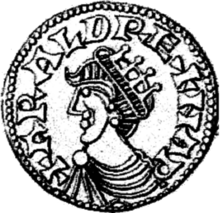Harald Hardrada
| Harald Hardrada | |||||
|---|---|---|---|---|---|

Coin of Harald as the sole Norwegian king, "ARALD REX NAR[vegiae]". Imitation of a type of Edward the Confessor.
|
|||||
| King of Norway | |||||
| Reign | 1046 – 25 September 1066 | ||||
| Predecessor | Magnus I | ||||
| Successor | Magnus II | ||||
| Co-ruler | Magnus I (until 1047) | ||||
| Born | c. 1015 Ringerike, Norway |
||||
| Died | 25 September 1066 (aged 50–51) Stamford Bridge, Yorkshire, England |
||||
| Burial | Trondheim; Mary Church until 12th century, Helgeseter Priory until 17th century (demolished) | ||||
| Spouse |
Elisiv of Kiev Tora Torbergsdatter |
||||
| Issue |
with Elisiv Ingegerd, Queen of Denmark and Sweden Maria Haraldsdatter with Tora Magnus II, King of Norway Olaf III, King of Norway |
||||
|
|||||
| House | Hardrada | ||||
| Father | Sigurd Syr | ||||
| Mother | Åsta Gudbrandsdatter | ||||
| Religion | Catholicism | ||||
| Full name | |
|---|---|
| Haraldr Sigurðarson |
Harald Sigurdsson (Old Norse: Haraldr Sigurðarson; c. 1015 – 25 September 1066), given the epithet Hardrada (harðráði, roughly translated as "stern counsel" or "hard ruler") in the sagas, was King of Norway (as Harald III) from 1046 to 1066. In addition, he unsuccessfully claimed the Danish throne until 1064 and the English throne in 1066. Prior to becoming king, Harald had spent around fifteen years in exile as a mercenary and military commander in Kievan Rus' and of the Varangian Guard in the Byzantine Empire.
When he was fifteen years old, in 1030, Harald fought in the Battle of Stiklestad together with his half-brother Olaf Haraldsson (later Saint Olaf). Olaf sought to reclaim the Norwegian throne, which he had lost to the Danish king Cnut the Great two years prior. In the battle, Olaf and Harald were defeated by forces loyal to Cnut, and Harald was forced into exile to Kievan Rus' (the sagas' Garðaríki). He thereafter spent some time in the army of Grand Prince Yaroslav the Wise, eventually obtaining rank as a captain, until he moved on to Constantinople with his companions around 1034. In Constantinople, he soon rose to become the commander of the Byzantine Varangian Guard, and saw action on the Mediterranean Sea, in Asia Minor, Sicily, possibly in the Holy Land, Bulgaria and in Constantinople itself, where he became involved in the imperial dynastic disputes. Harald amassed considerable wealth during his time in the Byzantine Empire, which he shipped to Yaroslav in Kievan Rus' for safekeeping. He finally left the Byzantines in 1042, and arrived back in Kievan Rus' in order to prepare his campaign of reclaiming the Norwegian throne. Possibly to Harald's knowledge, in his absence the Norwegian throne had been restored from the Danes to Olaf's illegitimate son Magnus the Good.
...
Wikipedia
